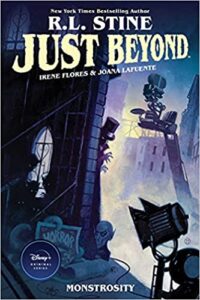

Strange Star by Emma Carroll
Delacorte Books for Young Readers, 2018
ISBN-13: 978-0399556050
Available: Hardcover, Kindle edition
In a recent interview, R.L. Stine expressed his frustration with the writing advice “write from your heart.” To paraphrase, he said “I don’t write from the heart. I write to entertain.”
You may argue that Stine writes formula fiction, which can be predictable, and that it’s shallow to write only to entertain. Only you can make that decision, but know that just because you are writing out of love, that doesn’t mean your writing will be loved, or even understood, by the audience you are trying to reach. I’m writing about children’s books here because that’s what I love and where I’ve recently seen examples of this, but if you’re writing for any audience, this still applies. In general, people who read to escape are looking for a good story, one that flows. They don’t want to have to work for their chills and thrills. I think that’s particularly true for children and teens.
I’ve come across two books this month that illustrate this perfectly. The first one, which I recently reviewed here, Out of the Wild Blue, by the outstanding children’s author Blue Balliett, was a tribute to Nantucket and its ghosts. It is clever and literary, and the worst book she’s ever written. I read it because I was asked to by another school media specialist who couldn’t get through the first 20 pages. Both of us are baffled at the amazing reviews this book has gotten from other librarians and reviewers. Heavy on atmosphere, this book shorted us on character development and plot. It was WORK for me to get through it, and what kid wants to have to work for the creepiness and chills you expect in a ghost story? I mean, the story is practically a love letter, but it’s not successful as an accessible ghost story for children. Or, for that matter, for at least two other adults with expertise in children’s literature.
The second, Strange Star, by Emma Carroll, has a lot of originality, although it’s not necessarily successful at getting the reader to fully suspend disbelief, and some of the pieces don’t connect as smoothly as they could. Strange Star centers on the events of the “haunted summer” during which Mary Shelley first conceived of Frankenstein. The first point of view character, is Felix, a free black servant boy working for Lord Byron at the Villa Diodati, whose goal is to convince Byron to take him back to England as a footman. His story is told in third person. We get Felix’s impressions of Byron, the Shelleys, and their friends, and some pretty detailed information on them is communicated through him. Felix isn’t only used as a way to communicate information, though. He is a character with agency and his own motivations. The second point of view character, Lizzie, an English village girl who was struck by lightning, blinded, and kidnapped by a scientist obsessed with using electricity to resurrect the dead, speaks in her own voice. Her experience of the same group of people that Felix admires is a terrifying one.
The author named many of the fictional characters in the book after characters in Frankenstein as well, even naming the scientist Francesca Stine. She managed to include historical figures like William Godwin, Mary’s father (a relatively minor part of her life after she ran away with Shelley) as a character, whose motivations and actions help move the story toward its conclusion. The messages of and ideas behind the creation of Frankenstein come through clearly in the book—clearly Carroll did her research and used it creatively.
As someone who’s read Frankenstein and also read a lot about Mary Shelley, I found this to be really well done and clever. It is vivid, not just in its descriptions and setting (the title is Strange Star for a reason), but in its portrayal of terrible emotions, particularly grief. Carroll also did a nice job of seamlessly integrating diversity into her characters. But I am not the audience. This is a book written for middle-schoolers, most of whom will not yet have read Frankenstein or heard of Mary Shelley. They won’t even yet have encountered the work of Percy Shelley or Lord Byron. They will miss most of the references and won’t be able to connect the dots when things are implied rather than stated outright (okay, maybe you don’t want them to figure out that Claire Clairmont has a thing going on with Byron). You would have to love Frankenstein and be fascinated with the life of Mary Shelley to write this book, but so much of it will be above the heads of the readers it is targeted for!
I’m sure there are more readers for this than for Balliett’s book, because Carroll handles plot and character development much more effectively—parts of the book are disturbing and even terrifying—but while Strange Star is definitely one to remember, and certainly one I’d recommend to fans of Mary Shelley, it’s more the book that Carroll wanted to write than the one her target audience will appreciate.
As an adult choosing or reviewing a children’s book for a child or teen, it can be easy to forget that we can’t read these books as if they’re written for us when making recommendations. And as an adult choosing to write a book for a child or teen, or really anyone looking to read for pleasure, it’s important to recognize that, if you want to reach readers, writing from your heart is not enough.







Follow Us!